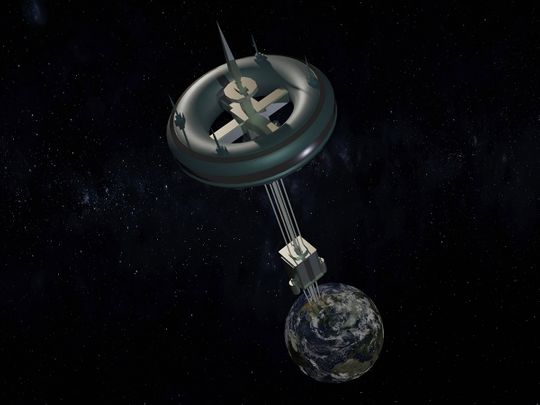
In the not-so-distant future, you might press a button in an elevator that says ‘Zero G’ – and launch yourself into space.
Click start to play today’s Word Search, where special deliveries to a ‘space station’ via an elevator may soon be a reality.
Ever since the 1960s, scientists and engineers have been playing with the idea of a super-tall, slim tether that is capable of delivering people, satellites, and other goods to high Earth orbit, in elevator cars that are the size of trains.
Even renowned science fiction writer Arthur C. Clarke wrote about it in his award-winning bestseller, The Fountains of Paradise, which depicted a space elevator being constructed in the 22nd century.
The idea is a good one, theoretically, according to a report in the US-based news website Mashable. Space infrastructure could be delivered without spending a Dirham for fuel. Solar energy at the top of the elevator could power the whole ride. The efficient system would reduce the problem of space junk. And all the things futurists have been dreaming about – asteroid mining, lunar settlements, cloud cities above Venus, Mars colonies – could suddenly become a real possibility.
It makes sense economically, too. According to US-based SpaceX, the spacecraft manufacturer founded by South African billionaire Elon Musk, it costs $6,000 per pound (Dh22,033 per 450g) to deliver cargo to space in its rockets. The Space Shuttle, which was an orbital spacecraft system that was operated by the US-based National Aeronautics and Space Administration (Nasa) until 2011, used to make deliveries for a whopping $120,000 per pound (Dh440,000 per 450g). But according to the Mashable report, space elevator scientists estimate it can be done below $100 per pound (Dh367 per 450g).
So, what’s stopping engineers and scientists from making a space elevator?
There’s definitely interest – China and Japan are producing plans for constructing a space elevator, both on and off Earth. China, for instance, unveiled plans for a ‘Sky Ladder’ in April 2021, as part of its plan for permanent habitation on the moon. An engineer at a university in Canada also published a paper about how it would be possible to build such a contraption in this very decade.
It could be done, but there are a lot of moving parts that need to operate perfectly. For one, a tether that tall would carry so much tension, it would need to be built out of incredibly strong materials – not even the steel or aluminium allows of spaceships will cut it. What could work, according to an April 2019 report by the American Association for the Advancement of Science, is a high-tech form of carbon that’s similar to diamonds, but far tougher, lighter, and more flexible: single-crystal graphene. But it’s still being tested and developed, and is barely out of the lab.
There’s also heavy scepticism about whether the tether will hold up. While the physics involved is sound, the chemistry may not be up to par. Some engineers believe that no matter what material is used to construct the elevator, the tension it involves is so great that the tether could collapse at the slightest provocation.
Still, many consecutive projects around the world are underway to make the space elevator dream a reality. Could it just be a matter of time, before we’re hurtling into space at the press of a button?
What do you think? Play today’s Word Search and tell us at games@gulfnews.com.



